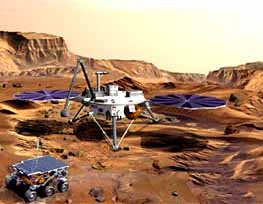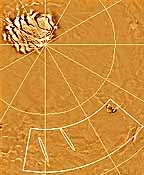| . |  |
. |
|
by Bruce Moomaw  Pasadena - October 18, 1999 - As a result of a meeting of 132 planetary scientists held last week in Houston, the possible choices of a landing area for the Mars Surveyor 2001 Lander have officially been reduced to two -- with one of them the overwhelming favorite.
Pasadena - October 18, 1999 - As a result of a meeting of 132 planetary scientists held last week in Houston, the possible choices of a landing area for the Mars Surveyor 2001 Lander have officially been reduced to two -- with one of them the overwhelming favorite.The Mars Surveyor 2001 Lander was originally intended to be the first mission designed to collect samples of Martian rocks and soil for later return to Earth -- with the samples being selected by the "Athena" rover that would have had a range of several kilometers. The mission had to be sharply scaled down in early 1998 because of budgetary problems. It now consists of a lander similar to the 1998 Mars Polar Lander, but carrying several new experiments;
This has naturally led to some revision in the mission's scientific goals -- but its overall purpose is still to provide us with our first surface look at Mars' "ancient highlands", which cover most of the planet's southern hemisphere, and which (judging by their cratering) date back to the planet's earliest days 4 to 4.5 billion years ago, with little geological change since then. This was the period in which it's thought that Mars, for a few hundred million to perhaps a billion years, had a dense carbon dioxide atmosphere which it later lost -- and which not only provided enough air pressure for liquid water to be able to exist on the surface, but may have provided enough "greenhouse effect" warming to raise the surface temperature above freezing, allowing lakes, rivers and perhaps even seas to exist there. This would have provided promising environment for the evolution of early single-celled life forms before the environment turned hostile. It was also the period when Mars' volcanic activity was far more intense than it is now -- which means that, even if Mars' atmosphere couldn't warm its overall surface temperature above freezing, there are likely to have been extensive areas of hot springs that could have been hospitable for the evolution of life. If fossils of ancient Martian microbes still exist anywhere on the planet's surface, this is the most likely area to find them. The 2001 Lander can't detect such microfossils; but it can at least confirm whether or not geologists are right in their interpretation of many surface features seen from orbit in this terrain that seem to be dried-up lakebeds, channels carved by running water, and sediment deltas -- and allow us to judge with greater accuracy which of them are most promising as ancient fossil beds. Strangely, despite the intense scientific interest in this area, the 2001 Lander is scheduled to be the very first Mars mission to land there. The two Vikings and Pathfinder all landed on the "northern plains", regions of considerably smoother and lower-altitude terrain which, for still unknown reasons, cover most of Mars' northern hemisphere. These areas are safer for spacecraft landings; but they have also clearly been resurfaced by volcanic lava flows and other processes as recently as a billion years ago, long after Mars' atmosphere dropped down to a mere trace and its temperature dropped to well below freezing. Later this year the Mars Polar Lander is designed to land on the "layered terrain" just north of the edge of the Martian south polar cap -- an area of immense interest to understanding present and past climates. But again this region also appears to have been resurfaced - and within only the past few hundred million years.
Mars 2001 Landing Zone Parameters The landing area also must be between 2.5 and 3 km lower in altitude than Mars' surface average, in order for there to be enough air for the craft's braking parachute to work properly, but not so much that wind gusts might damage its solar panels. Furthermore, the landing area must not be so rugged as to seriously endanger the spacecraft, although NASA intends to use a new navigation system on this spacecraft that can land it within 10 to 13 km of its target point -- far better than any previous Mars lander. The photos taken by the Viking orbiters during the Seventies, wwhich cover most of Mars with a resolution of 50-100 meters, were our only guide in this selection until Mars Global Surveyor began mapping the planet last year with three very useful instruments:
As for scientific factors in choosing a landing site, NASA wanted to ensure that the Lander had a good chance of studying "aqueous" minerals: that is, minerals deposited by liquid water in some form -- whether on an ancient lakebed, a fan of sediment deposited by one or more of Mars' ancient running-water channels, or perhaps even an area of ancient volcanic hot springs. If possible, it also wanted the Lander to be able to photograph large surface features such as hills -- especially if rock strata were visible that could provide a record of Mars' early geological history. The main purpose of the 2001 Lander, as I say, is to provide as much information as possible on the geological history of early Mars, and in particular on how much liquid water was on its surface and how hospitable the planet might have been for life. With all these criteria in mind, a national workshop of planetary scientists was held back in January 1998. At that time, the plan was still for the 2001 Lander to use the Athena rover to collect samples from kilometers around the landing point for return to Earth. However, since then the mission's goals were scaled back -- and so a second workshop was held in June 1999. At that meeting, over 60 sites were proposed by various scientists, using both the sweeping Viking orbiter maps of Mars and the new data that had just started to come in from Mars Global Surveyor. Two proposals were particularly unusual and striking. One was to land the craft on or near the "White Rock" -- a 200-square kilometer patch of very light-colored material, in the floor of a crater that seems to have served as an ancient lake, that is thought likely to be an "evaporite" deposit -- that is, an ancient salt flat containing carbonate minerals as well as other salts, any of which could be very promising fossil deposits. The other proposal was to actually land the craft on the floor of the Valles Marineris ("Mariner Valley") -- the gigantic network of canyons that runs for 4000 km along Mars' surface and reaches depths of up to 8 km. Much of the Valley is so deep that it may have retained big frozen-over lakes of water for hundreds of millions of years after water had frozen solid on the rest of Mars' surface -- and in fact there are sheets of material on much of its bottom that appear to be lake deposits. If the Lander touched down there, it could not only examine these sediments, but obtain spectacular and scientifically important photos and infrared mineral spectra of the dozens of layers of material visible in the Valley's towering walls, which may be ancient lava flows or layers of sedimentary rock or both. Part two: Mars Rock Fest Ends In Two Choices

|
| |||||||||
| The content herein, unless otherwise known to be public domain, are Copyright 1995-2016 - Space Media Network. All websites are published in Australia and are solely subject to Australian law and governed by Fair Use principals for news reporting and research purposes. AFP, UPI and IANS news wire stories are copyright Agence France-Presse, United Press International and Indo-Asia News Service. ESA news reports are copyright European Space Agency. All NASA sourced material is public domain. Additional copyrights may apply in whole or part to other bona fide parties. Advertising does not imply endorsement, agreement or approval of any opinions, statements or information provided by Space Media Network on any Web page published or hosted by Space Media Network. Privacy Statement All images and articles appearing on Space Media Network have been edited or digitally altered in some way. Any requests to remove copyright material will be acted upon in a timely and appropriate manner. Any attempt to extort money from Space Media Network will be ignored and reported to Australian Law Enforcement Agencies as a potential case of financial fraud involving the use of a telephonic carriage device or postal service. |